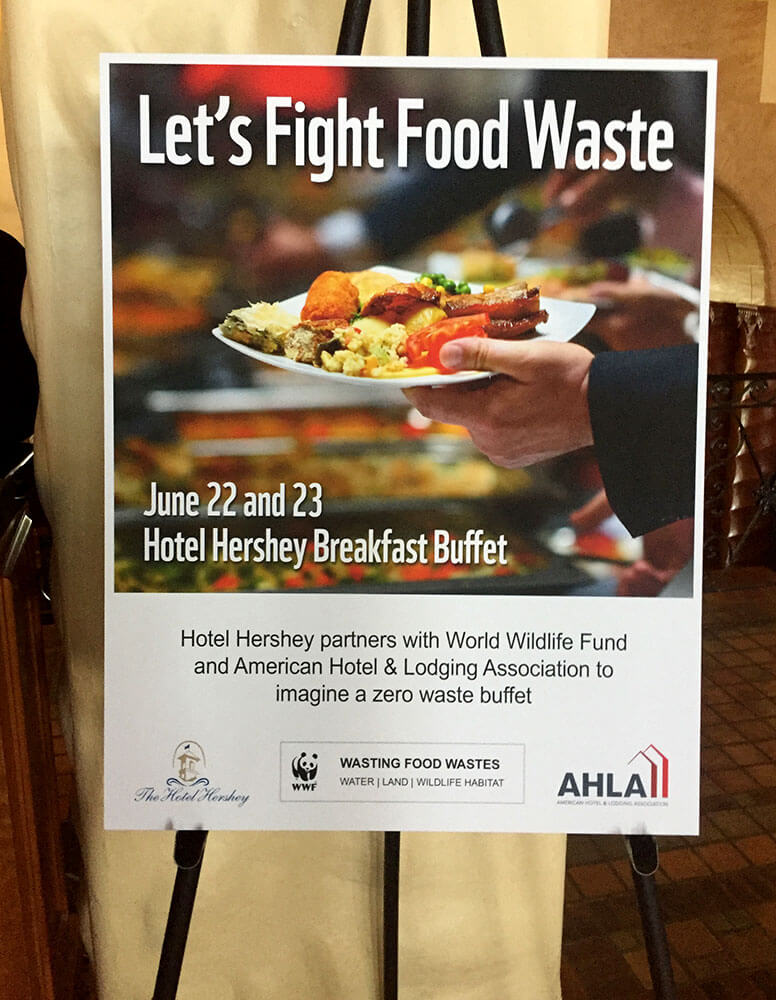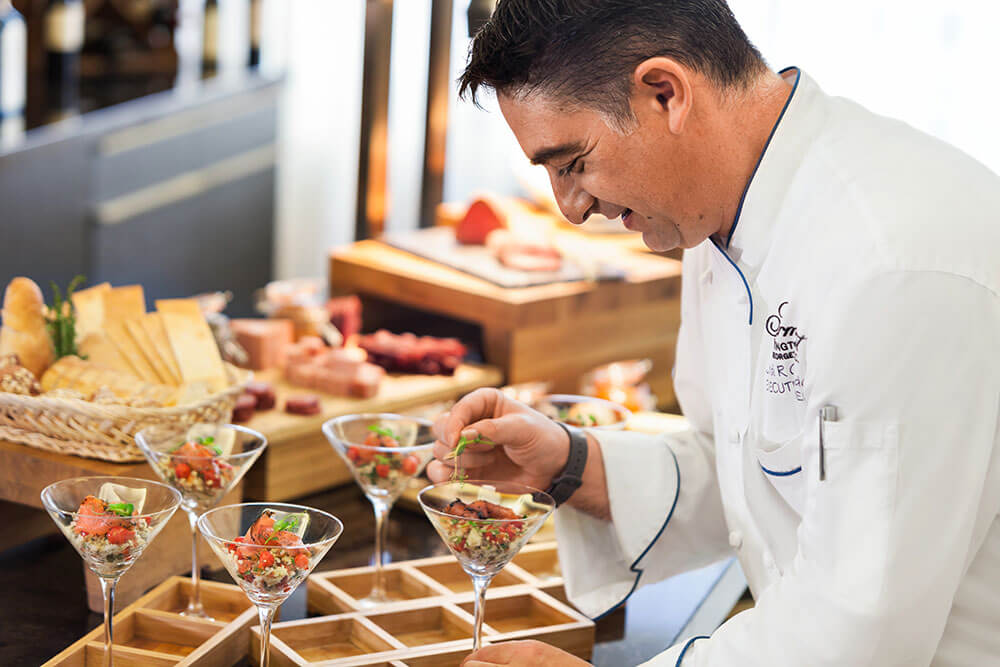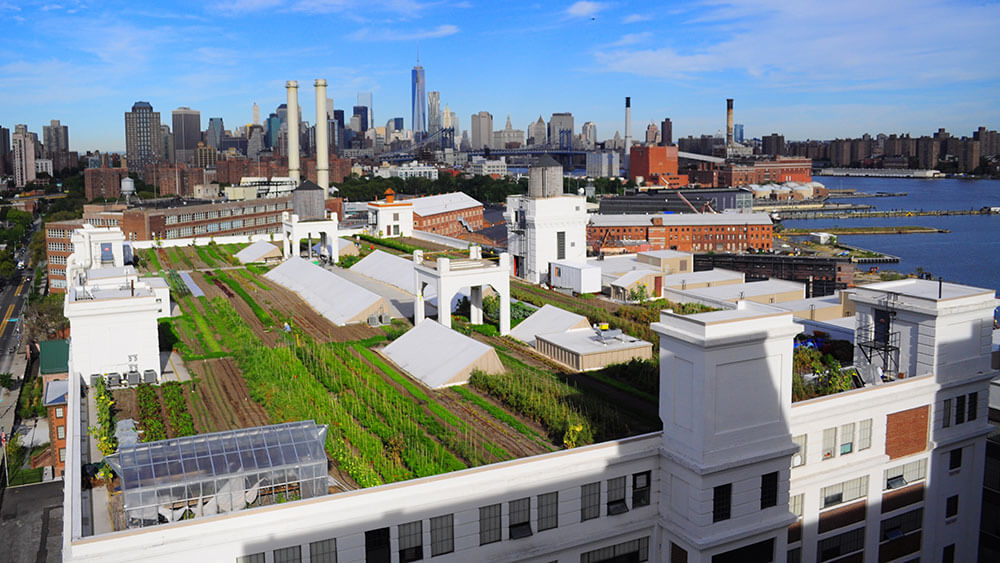
It’s estimated that there will be 2 billion more mouths to feed around the world over the next three decades. (Painting by Dennis Wojtkiewicz)
It’s clear that our food systems will need to change — and change radically — if we are to safeguard the planet and feed a growing population.
What can be done? The best place to start, and where we, the business events industry, can have the greatest impact, is with food waste — what a planner called “the inconvenient truth about event planning” when she spoke with Convene about the problem in 2015. “We all know it’s happening,” she said then. “We don’t like it. But we don’t know how to address it.”
The good news is that new approaches, new partnerships, and new resolve — spurred on by the urgent threat food waste poses to the planet — are changing that. Here’s how.
It’s one of the biggest paradoxes of our time — for many people, food is less expensive and more abundant than at any other time in the world’s history. And for many of those planning meetings and events, it’s been accepted practice to offer guests buffets piled high with pyramids of food, thinking that choices were limited only by the size of the budget.
But, as science journalist Amanda Little reports in her recent book, The Fate of Food: What We’ll Eat in a Bigger, Hotter, Smarter World, we are looking at a future with much less on our plates. Global crop production is projected to decline by 2 to 6 percent every decade for the rest of this century because of drought, heat, and flooding, she writes. And even as crop yields decline, there will be more mouths to feed: By 2050, the world’s population is expected to have grown 30 percent.
RELATED: Food: ‘A Powerful Tool for Change’
One of the best hopes for avoiding environmental disaster, scientists increasingly assert, is found in food, and in making radical changes to the way we produce and consume it. Most importantly, we need to dramatically reduce the amount of food that is lost and at a crossroads, wrote the authors of a report created at the World Food Summit, convened in Copenhagen by the United Nations in August. Cutting global food loss and waste in half by 2030 “is critical if we’re to feed the world without destroying the planet.”

The Hotel Hershey, in Hershey, Pennsylvania, joined with American Hotel & Lodging Association and World Wildlife Fund to demo ways to cut food waste. (Courtesy WWF)
Taking a Leadership Role
The World Wildlife Fund (WWF) has made a name for itself by protecting endangered sea turtle nests in the Galápagos Islands and working to safeguard coral reefs in the Pacific Ocean. But the 38-year-old environmental organization is also working toward environmental change in a very different kind of habitat: commercial kitchens in hotels and convention centers. WWF’s mission directly intersects, it turns out, with the work of meeting and hospitality professionals at the point of food waste and the urgent threats it poses to the planet.
Collectively, we throw away or otherwise lose about a third of the food that is produced in the world. Put another way, the Food and Agriculture Organization of the United Nations estimates that one-third of the world’s total agricultural land area is used to grow food that is wasted. We pay an ethical price — if we recovered just a third of that amount, it would more than feed the 40 million Americans who don’t have reliable access to good food. But the environmental cost is dire as well. The energy we spend to produce the food we throw away represents approximately 8 percent of the annual total of global greenhouse gas emissions and is a major contributor to deforestation and the depletion of global water sources. And wasted food ends up in landfills, producing a large amount of methane, a more powerful greenhouse gas than CO2.
On the surface, the solution seems simple: Just. Stop. Throwing. Food. Away. But food waste is a difficult problem to solve, Pete Pearson, the WWF’s director of food-waste research, told Little in The Fate of Food. “There’s no single technology or policy intervention that can nip this thing in the bud,” he said. “It happens everywhere, upstream and downstream, in fields, warehouses, packing, distribution, supermarkets, restaurants, and homes.”
If food waste happens everywhere, it also happens especially in the kinds of commercial kitchens that produce the meals to feed those who attend the conferences and special events organized by the events industry. While individual households — where most food is consumed — are responsible for the majority of the food waste in the United States, consumer-facing businesses, including restaurants, hotels, and grocery stores, are a close second. They account for 40 percent of total food waste by weight — and commercial kitchens account for a stunning two-thirds of that total.

Monica McBride
WWF began working with Hilton International a few years ago, collaborating on conservation strategies that include reducing food waste in the hotelier’s supply chain and operations, said Monica McBride, WWF food-waste-education project manager.
That led to wider partnership, launched in 2017 between WWF and the American Hotel & Lodging Association (AHLA). Supported by funding from the Rockefeller Foundation, the WWF and AHLA conducted a three-month-long study in a cross-section of 10 hotel kitchens across the U.S., including Hilton, Marriott, Hyatt, and independent hotels. The goal, McBride said, was to learn as much as possible about where and why waste was occurring and to determine what practices might be most effective in reducing it. The initiative included embedding researchers into kitchens to observe staff behavior and operations — the same ethnographic research techniques employed by anthropologists and social scientists — as well as field-testing a variety of food-waste reducing strategies, McBride said.
The training challenged staff to think about food waste in a larger context than just in terms of the amount of food that’s thrown away each day or even the amount that can successfully be donated to others. In the test kitchens, participants experimented with adjusting multiple aspects of participants’ food-and-beverage operations, looking at everything — the ways in which menus are planned, ingredients are chosen, food portions are calculated, and how food is presented and served, as well as what happens to prepared food that goes uneaten.
RELATED: What Meeting Planners Can Do to Reduce Food Waste
Over the three months of the study, participants were able to cut waste by an average of 10 percent and some kitchens managed to cut waste by as much as 38 percent. The test kitchens also saved money, cutting food costs by an average of 3 percent. WWF shared the results widely, publishing them in a set of training materials at hotelkitchen.org.
WWF also embarked on a second study, again with the participation of AHLA and the Rockefeller Foundation, which took the research from the initial study and went deeper, this time looking at how organizations can implement successful tactics and strategies in a way that would make them stick.
The studies helped researchers understand what was working, McBride said, but they also revealed key gaps in the food-waste-reduction efforts. Addressing them represents opportunities to accelerate progress: They include increasing awareness by measuring food waste, educating kitchen staff and clients, and making connections across silos.
GAP NO. 1: AWARENESS

Mac Campbell
One of the most startling results was how much of a difference there was between the amount of food hotel kitchens were actually sending to landfills, and how much food chefs and hotel operations staff estimated was being wasted. “Most hotels simply had no idea of how much food they were wasting, because they weren’t measuring it,” McBride said. When researchers asked chefs to estimate how much food they thought was going to landfills, sometimes “the amount was off by as much as 100 percent,” she said. The amount of overproduction “was eye-opening for the chefs,” many of whom thought they were doing a pretty good job when it came to avoiding waste, she said. In one audit of meals prepared for 800 people, for example, only 55 percent of the food that was pre- pared was consumed, McBride said.
The study showed that separating and measuring food waste, on its own, had the effect of reducing the amount generated in a hotel kitchen. When kitchen culinary staff get to see the quantity of food waste they are producing in the kitchen and the amount returning from the buffets, they make changes to their production techniques and portion sizing, the study found.
A big takeaway, McBride said, was understanding the role that communication between meeting planners and F&B managers could play in driving change. Just by asking food-and-beverage operations to create reports on food waste after events, planners help create awareness and drive change.
“Change comes because clients ask for it,” said Mac Campbell, deputy director of the Baltimore Convention Center (BCC), which participated in the second part of the WWF study. When his team talks to meeting planners about sustainability, “we beg them” to put food-waste-related language in their RFPs, he said. “It is our job to step up, but that gives us reinforcement for investing financially [in food- recovery efforts] and in the time that it takes to train our staff. If the client isn’t asking [for sustainability] or if they really don’t care or don’t articulate that they care, then we’ve got a much harder battle to fight.”

A chef measures portions at the Fairmont Le Montreux Palace in Switzerland. Research conducted by WWF and AHLA has shown that just measuring food alone reduces waste amounts.
GAP NO. 2 : EDUCATION
When executives at the BCC volunteered their center for the WWF deep-dive study, they already had a slew of sustainable practices in place, including a garden where culinary staff members raise herbs and vegetables. But after working for three months with consultants Aurora Dawn Benton, the founder of sustainability-consulting company Astrapto, and Joan Plisko, president of Plisko Sustainable Solutions, who led training workshops with the staff, there was an 83-percent increase in food donations and a 73-percent decrease in waste to landfills, measured on a per-attendee basis.
One thing that the experience made clear, Campbell said, “was that it’s okay if you have a few people talking the talk and walking the walk, but until you really get your frontline employees in the mix and fully engaged, it’s really, really hard to move the needle.” At the BCC, where Centerplate manages the food-and-beverage operation, the entire kitchen staff underwent training. But the training also included the sales and marketing staff and the services team from the building side, Campbell said. “In the end, the sales team has just as much of an impact on process as the operations team does. Because unless we articulate these points early on in the sales process, we’re not going to be able to get the buy-in from the client that we really need to move the needle the [most].”
Making meaningful progress in cutting food waste also will require a shift in what a BCC white paper, written by Astrapto and published in July, described as the “pervasive industry practice of overproduction.” In hospitality, the paper continued, “we never want to run out of food, so measures are taken to ensure there is always enough. Unfortunately, there is always too much.”
The reaction to encountering large quantities of food and giant portions has become much less positive in other countries and there are signs that attitudes are changing here, too.“I think the definition of quality is probably shifting a little bit,” Campbell said. “Some people might think that an overflowing chafing dish is quality. But others might just talk about the quality of the food.”

The Brooklyn Grange grows more than 80,000 pounds of produce annually on New York City rooftops, including at the Brooklyn Navy Yard (shown), their biggest urban farm. (Anastasia Cole Plakias)

The Brooklyn Grange will oversee a one-acre ‘farm’ planned for the roof of the Javits Center in New York, where bees currently produce honey for the center’s use. (Courtesy Javits Center)
GAP NO. 3 : LINEAR, RATHER THAN CIRCULAR THINKING
At New York City’s Javits Center, management recently announced a reinvention of its food-service brand, called Cultivated, which is based on a partnership between New York City–based catering company CxRA and Levy Convention Centers. The intention is to deliver the high-concept, high-quality food service that customers now expect, said Tony Sclafani, the Javits Center’s senior vice president and chief communications officer, but it also rests on a full-scale sustainability makeover.
An upcoming expansion to the center will add a one-acre farm to the rooftop, which is expected to produce 40,000 pounds of food a year, according to Sclafani. The center is also adding a bakery. The plan, he said, “is to take all of our leftover breads in order to brew a kind of a toast ale beer specifically for the Javits Center.” A recent menu from the center created to showcase food sustainability included honey from the center’s rooftop beehives, pickled vegetables that otherwise would have gone to waste, bread pudding made from leftover pastries, and sauce made from “ugly” — otherwise unsellable — tomatoes.
Those kinds of creative uses represent a shift in thinking about food production and consumption as a circular, rather than linear process. “There isn’t any waste in nature,” Darby Hoover, a food-waste specialist at the Natural Resources Defense Council, points out in The Fate of Food. “Anything that dies in nature becomes food for something else. Humans have created waste as a concept, and we should be able to uncreate waste as a concept.”
GAP NO. 4: CONNECTIONS
One of the most pressing problems WWF discovered was the lack of connection between organizations that have the capacity to distribute food — like food shelters and soup kitchens — to institutions like hotel kitchens that are producing food that could be donated, McBride said.
At the BCC, transporting excess food was a huge hurdle, Campbell said. Nonprofits “generally don’t have the resources to have drivers available to pick up food,” he said, “and we can’t always have a driver available to deliver.” The solution in Baltimore was an app called “Meal Connect,” created by the local food bank to allow its volunteers essentially “to be the Uber driver, taking food directly from our kitchen to the soup kitchen or meal hall that the nonprofit is serving in then,” Campbell said. “They connect the dots, and it’s increased how quickly and how regularly we can donate food.”
RELATED: Yes, You Can Donate Excess Food
WWF is currently in “full outreach mode,” holding events in U.S. cities specifically for the purpose of making those connections and providing training, McBride said. Over the last few months, the organization has held events in Miami, Dallas, and Denver, to bring local hotels into the same room with organizations that accept food donations, animal food scraps, or compost, McBride said.
In October, the Javits Center also held its own “Food Waste Fair,” inviting local food-recovery-related nonprofits and businesses to share solutions with meeting professionals and others. There have always been individual events that have done an exemplary job of donating leftover food, Sclafani said. “What we’re looking to do is really bring that in house and make it more of a mandate to all of our shows and our guests.”
Changing the Story
“None of this is rocket science, and none of this is brand-new information,” Campbell said. “But we want to be [a place that] people can look to as a case study for best practices, and to be able to tell this story and why it’s important. People always talk about conventions and tourism. Is the main difference the economic impact you bring to a community?” The real story is about how people and communities are affected, he said.
In Baltimore, where the food-insecurity rate is twice the national average, when food donations are increased, “there are real people that feel that impact,” Campbell said. “Every destination is going to have a different story to tell and be on a different journey in creating these initiatives.”
Barbara Palmer is Convene’s deputy editor.
Earn One Hour of CE Credit
By reading this story, its related stories, and accompanying material linked below, you will be ready to earn one hour of CE credit toward CMP certification from the Events Industry Council.
Once you’ve finished reading this article, read “A Case Study for Food Waste Reduction at the Baltimore Convention Center.”
To take an online test to earn CE credit, and for access to additional CMP Series stories, go to our CMP Series page.
The Certified Meeting Professional (CMP) is a registered trademark of the Events Industry Council.
